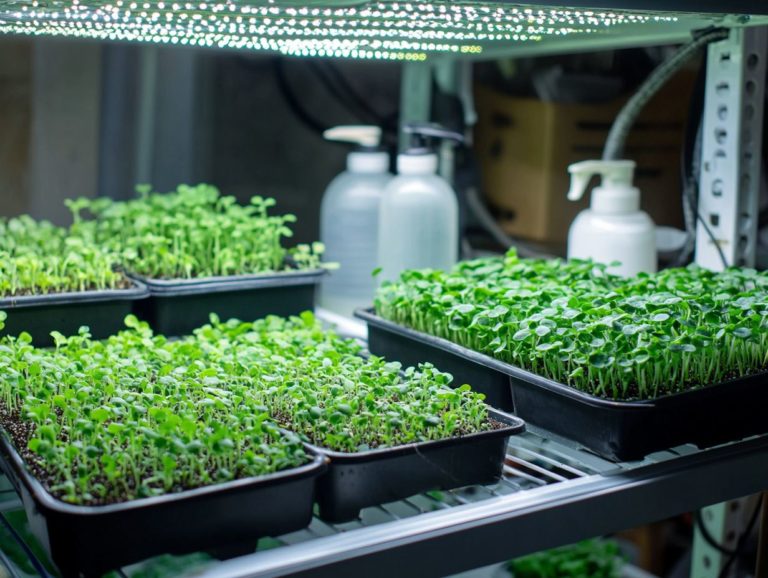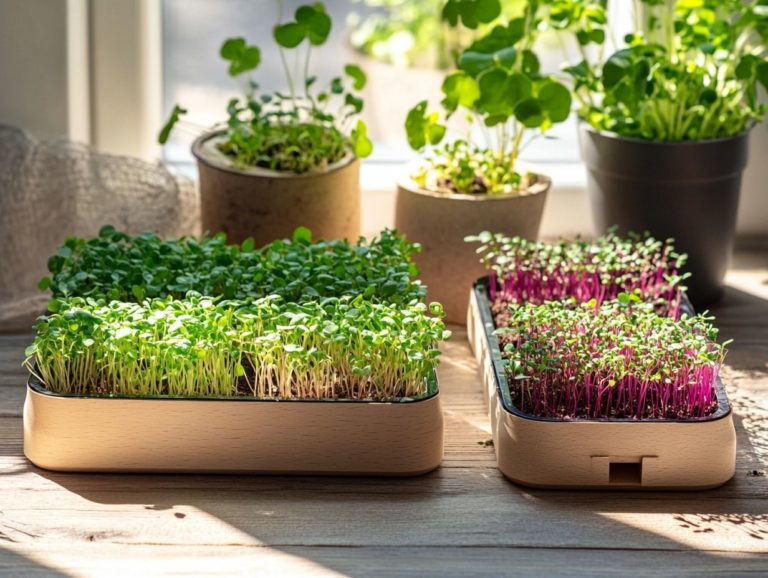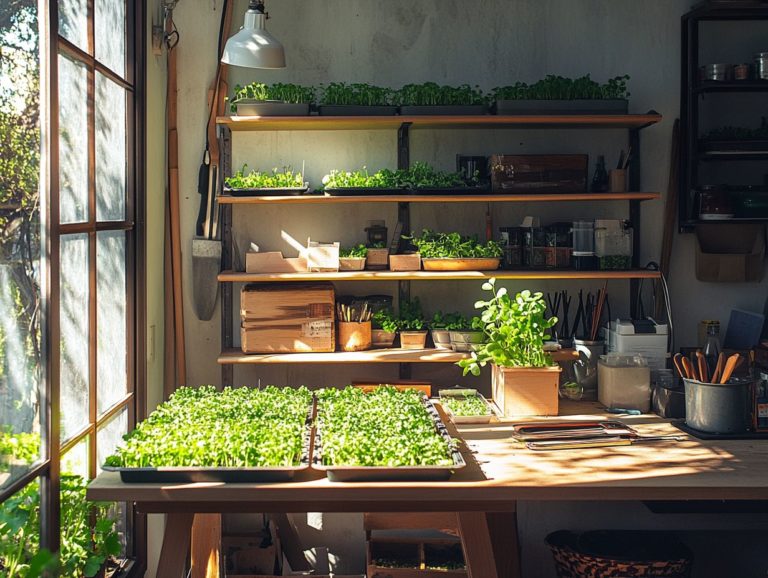Top 5 Pest Control Supplies for Microgreens
Growing microgreens can be a truly rewarding endeavor. However, the sudden appearance of pests can quickly transform your flourishing garden into a challenging battleground.
Understanding how to safeguard your delicate greens is essential for successful cultivation. Get ready to discover five powerful pest control supplies that will protect your microgreens:
- Neem Oil
- Diatomaceous Earth
- Sticky Traps
- Beneficial Insects
- Horticultural Oil
This article also addresses common pests that harm microgreens, such as aphids and whiteflies, preventive measures, and non-toxic alternatives, arming you with the knowledge to help your microgreens thrive free from unwanted visitors.
Immerse yourself in this guide to discover how to cultivate a vibrant, pest-free garden with the help of organic pest control methods!
Contents
- Key Takeaways:
- 1. Neem Oil
- 2. Diatomaceous Earth – A Key Tool for Indoor Gardening
- 3. Sticky Traps – An Essential for Pest Monitoring
- 4. Beneficial Insects – Friends of Your Microgreens
- 5. Horticultural Oil – A Multi-Purpose Solution
- What Are the Common Pests in Microgreens?
- Unleash the Power of Neem Oil Against Microgreen Pests!
- What Are the Benefits of Using Diatomaceous Earth for Pest Control in Microgreens?
- Sticky Traps: A Game-Changer for Pest Control!
- What Are the Different Types of Beneficial Insects for Pest Control in Microgreens?
- Why Is Horticultural Oil Effective for Pest Control in Microgreens?
- How Can a Combination of These Supplies Improve Pest Control in Microgreens?
- What Are the Other Factors to Consider for Effective Pest Control in Microgreens?
- How Can One Prevent Future Pest Infestations in Microgreens?
- What Are the Non-Toxic Alternatives to Chemical Pest Control in Microgreens?
- How Can Proper Sanitation Help with Pest Control in Microgreens?
- What Are the Signs of a Pest Infestation in Microgreens?
- How Can a Business Ensure Safe and Effective Pest Control in Microgreens?
- Frequently Asked Questions
- Wondering what you need to keep your microgreens pest-free? Here are the top supplies!
- What is neem oil and how does it help with pest control for microgreens?
- How does insecticidal soap work to control pests on microgreens?
- What is diatomaceous earth and how is it used for pest control on microgreens?
- Can beneficial insects really help with pest control on microgreens?
- Are sticky traps a safe and effective method of pest control for microgreens?
Key Takeaways:

- Neem Oil is a powerhouse in pest control, protecting your microgreens without harming good bugs!
- Diatomaceous Earth dries out soft-bodied bugs, making it a safe option against fungus gnats.
- Sticky Traps are a cost-effective and easy-to-use tool for monitoring and controlling pests, helping you identify the type of pest infestation.
1. Neem Oil
Neem oil stands out as a robust organic pest control solution, especially in indoor gardening. If you re nurturing microgreens, this oil is your ally against common pests like aphids and whiteflies.
Its strength lies in its ability to disrupt these pests’ life cycles while promoting healthy growth. This makes neem oil an essential tool for any gardener committed to natural and sustainable practices, ensuring your microgreen crop thrives.
Extracted from the seeds of the neem tree, this oil targets the hormonal systems of insects, hindering their growth and reproduction, ultimately leading to their demise. You can easily apply neem oil using a spray bottle or garden sprayer, ensuring to cover the underside of leaves where these pesky critters often hide.
Neem oil also improves plant health. If you re inclined to explore homemade options, a simple mixture of soap and water can effectively deter a variety of pests, offering a convenient alternative that s always within reach. Apply neem oil every two weeks to keep infestations at bay and let your plants thrive!
2. Diatomaceous Earth – A Key Tool for Indoor Gardening
Diatomaceous Earth is a natural and highly effective pest control solution, ideal for protecting your microgreens from unwelcome visitors like fungus gnats. This organic remedy prioritizes environmental safety while promoting the overall health of your plants.
This fine, powdery substance works wonders by drying out soft-bodied bugs, making it particularly adept at tackling not just fungus gnats but also aphids, thrips, and spider mites common nuisances in indoor gardens.
To apply it effectively, sprinkle a thin layer on the soil surface or directly onto the plants, ensuring ample coverage while allowing beneficial insects those that help control pest populations naturally to thrive.
When using diatomaceous earth, it’s essential to take some safety precautions. Wear a mask to prevent inhaling the dust and keep it out of reach of pets, as it can irritate their lungs. By integrating this method into your organic gardening practices, you can maintain a healthy ecosystem while efficiently managing pest populations.
3. Sticky Traps – An Essential for Pest Monitoring
Sticky traps are essential tools for pest control in your microgreens. They help keep your indoor garden thriving by monitoring and reducing pesky invaders.
These traps come in yellow and blue versions. Each color attracts specific insects.
By positioning them strategically at different heights and locations, you can boost their effectiveness dramatically.
When paired with other pest control strategies, such as organic sprays or the introduction of beneficial insects, these traps create a comprehensive approach to managing infestations.
By tracking the pests captured on these traps, you’ll quickly spot infestation levels and take action! This proactive monitoring ensures your microgreen environment thrives, leading to a more successful harvest.
4. Beneficial Insects – Friends of Your Microgreens
Beneficial insects are your allies in the fight against pests. They target nuisances like aphids and whiteflies effectively, fostering a balanced ecosystem for your plants.
These insects help maintain soil health and align with organic gardening principles by avoiding synthetic pesticides. Take ladybugs, for example; they’re relentless predators of aphids and can be easily introduced into your indoor setup.
Predatory mites are fantastic for managing spider mites, while parasitic wasps focus on various pest larvae.
Attract these helpful critters by planting companion flowers. Marigolds, basil, and dill provide food and shelter.
Creating a welcoming environment by maintaining humidity levels and offering cozy spots will encourage these beneficial allies to flourish, contributing to a healthier garden ecosystem.
5. Horticultural Oil – A Multi-Purpose Solution
Horticultural oil is an organic solution that targets pests effectively. It promotes healthier plant growth in microgreens.
This oil is available in refined mineral and vegetable-based forms. Each type offers unique benefits.
Use a fine mist spray for even coverage on leaves. Drench the soil to deter root pests.
Pairing it with neem oil enhances your pest control strategy, as these oils work together to disrupt insect life cycles.
Timing is key apply these oils during the cooler parts of the day to minimize the risk of plant burn from the sun.
Monitor environmental factors like humidity and temperature, as they can impact your pest control efforts significantly. Keeping a close eye on these conditions is essential for achieving optimal results.
What Are the Common Pests in Microgreens?
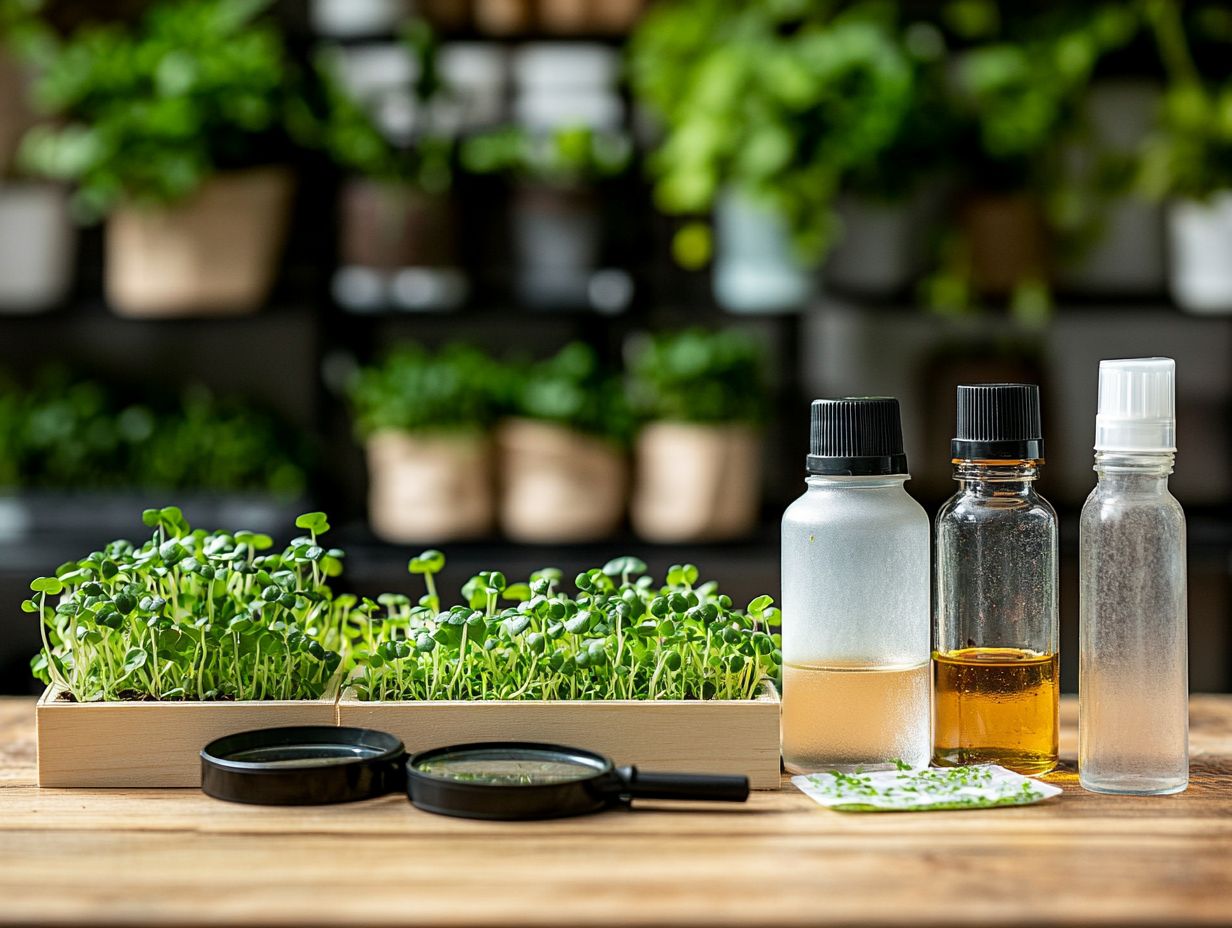
Microgreens are unfortunately not immune to a variety of common pests, such as aphids, whiteflies, and fungus gnats. These little invaders can threaten the health and growth of your plants. It is essential for you, as an indoor gardener, to recognize and effectively manage these issues to ensure a thriving harvest.
Understanding the traits of these pests is key to taking control. For example, aphids are small, soft-bodied insects that feast on the sap of your microgreens, causing stunted growth and potentially spreading disease.
Whiteflies, which look like tiny moths, can cause similar havoc by feeding and laying their eggs on the undersides of leaves.
As for fungus gnats, they can be somewhat elusive. They flourish in moist soil, with their larvae munching on the roots of your precious plants.
Early detection is paramount. Make it a habit to regularly inspect your microgreens for any signs of infestation, such as discolored leaves or strange webbing.
Employing sticky traps, ensuring good air circulation, and avoiding overwatering can significantly diminish pest populations and encourage healthier, more robust microgreens. For those looking to enhance their growing experience, understanding microgreen growing supplies is also beneficial. Additionally, consider homemade pest spray options.
Unleash the Power of Neem Oil Against Microgreen Pests!
Neem oil serves as a powerful ally in your quest for effective pest control in microgreens. It targets pesky culprits like aphids and whiteflies while remaining safe for the environment and even beneficial for plant health when used correctly.
Its secret weapon? Neem oil disrupts the hormonal systems of these pests, hindering their ability to feed, grow, and reproduce. This not only reduces their populations but also curbs their disruptive behaviors.
To harness the power of neem oil, just mix one to two tablespoons of neem oil with a gallon of water. Coat the tops and undersides of leaves thoroughly for maximum efficacy.
For the best outcomes, apply this mixture in the early morning or late evening. Applying at this time protects beneficial insects and enhances the oil s absorption.
What Are the Benefits of Using Diatomaceous Earth for Pest Control in Microgreens?
Using diatomaceous earth for pest control in your microgreens provides a wealth of advantages, particularly its effectiveness against nuisances like fungus gnats while fostering a healthier growing environment sans synthetic pesticides.
This natural powder comes from the remains of tiny marine organisms and is safe for your indoor gardening endeavors. It is remarkably simple to apply, making it a perfect option for both beginners and seasoned growers alike.
By sprinkling diatomaceous earth around the base of your microgreens or mixing it into the soil, you can establish a protective barrier that effectively wards off harmful insects. Its long-lasting properties mean you’ll require fewer applications, ultimately saving you both time and effort.
To seamlessly incorporate this natural solution into a comprehensive pest management strategy, think about pairing it with regular plant health monitoring and creating conditions that naturally deter pest outbreaks.
Sticky Traps: A Game-Changer for Pest Control!
Sticky traps are a game-changer for pest control in your microgreens. By utilizing these traps, you can catch and monitor pests like aphids and whiteflies, significantly reducing their impact on plant health and promoting better growth.
These traps not only help you identify pest populations but also act as a visual cue to keep you vigilant. For optimal results, strategically place sticky traps within your growing area, steering clear of direct sunlight to avoid premature stickiness while ensuring there s good air circulation.
Use these traps as part of your eco-friendly pest management. They reduce the need for chemical pesticides. Regularly inspecting and replacing the traps allows for timely interventions, creating an environment where your plants can truly thrive.
Start your pest management today for healthier and more vibrant microgreens!
What Are the Different Types of Beneficial Insects for Pest Control in Microgreens?
Want to see your microgreens thrive? Various beneficial insects play a crucial role in pest control. They effectively manage pesky nuisances like aphids and whiteflies through natural predation and parasitism, all while supporting your organic gardening practices.
Among these valuable allies are ladybugs, lacewings, and parasitoid wasps. Ladybugs are amazing! They can eat up to 50 aphids a day as larvae, and they keep getting hungrier as adults. Lacewing larvae, often called ‘aphid lions,’ are fierce hunters that take down aphids and mites, showcasing feeding habits that significantly reduce pest populations. Then there are the parasitoid wasps, which inject their eggs into pests, ensuring that their young hatch inside and feast on the host.
To attract these essential insects in your indoor gardening setup, consider incorporating flowering plants like dill and yarrow. These plants provide vital nectar sources. By maintaining a chemical-free environment, you can sustain their populations over time.
Why Is Horticultural Oil Effective for Pest Control in Microgreens?
Horticultural oil is an organic solution that suffocates pests like aphids and whiteflies on contact. This method offers safety for your plants while delivering impactful results.
The oil forms a thin film that blocks the breathing pores of these pests, leading to their demise. Unlike neem oil, which mainly acts as a repellent and disrupts insect growth, horticultural oil directly eradicates the targeted pests. This makes it a particularly valuable part of a pest control plan that combines different methods.
The versatility of application methods whether through foliar sprays or soil drenching further enhances its effectiveness while minimizing harm to beneficial organisms.
By incorporating horticultural oil into your routine, you can cultivate healthier microgreen crops and reduce your reliance on synthetic pesticides, fostering a more sustainable growing environment.
How Can a Combination of These Supplies Improve Pest Control in Microgreens?
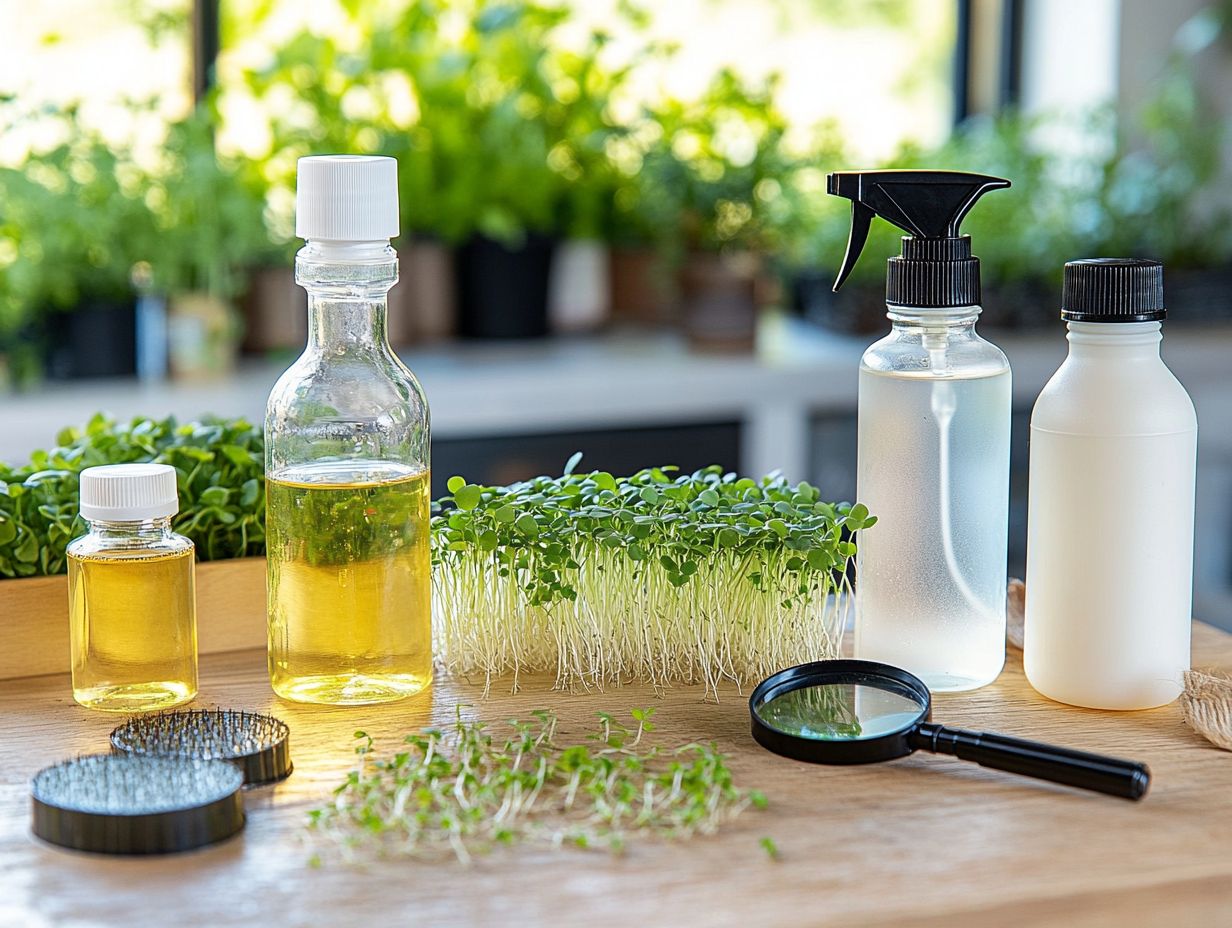
Combining various pest control supplies like Neem Oil, diatomaceous earth, sticky traps, and beneficial insects can significantly elevate the effectiveness of your pest management strategies in microgreens. This approach ultimately leads to healthier plants and higher yields.
This multi-faceted method tackles pests from different angles and minimizes the risk of developing resistant pest populations. For instance, Neem Oil disrupts the life cycle of pests, while diatomaceous earth provides a non-toxic physical barrier. Sticky traps offer a clever way to monitor pest populations, enabling you to intervene promptly when necessary.
To craft an effective pest control plan, start by assessing the specific pest issues that plague your microgreens. Integrate beneficial insects, such as ladybugs, which can naturally reduce aphid populations. For sourcing quality seeds, consider checking out the top 7 seed suppliers for microgreens. Regular inspections and diligent sanitation practices will enhance the synergy among these methods, creating a robust defense against a wide array of pest threats.
What Are the Other Factors to Consider for Effective Pest Control in Microgreens?
Effective pest control in microgreens involves considering a variety of factors that extend well beyond using just pest management products. You need to maintain optimal soil moisture, quarantine new plants, and adopt sound practices for indoor gardening.
These elements are crucial for reducing the risk of pest infestations. Certain environmental conditions can either promote or hinder pest populations. For instance, high humidity levels can create a welcoming atmosphere for pests like aphids or fungus gnats, while drier conditions might keep them at bay. Soil conditions, including texture and nutrient composition, also play a vital role in your plants’ vitality, making them either more resilient or more susceptible to pest attacks.
By implementing preventive measures such as rotating crops, utilizing companion planting, and regularly monitoring humidity levels, you can craft an inhospitable environment for pests. This strategy not only ensures healthier microgreens but also paves the way for a more bountiful harvest.
How Can One Prevent Future Pest Infestations in Microgreens?
To prevent future pest problems in your microgreens, adopt simple prevention methods. Quarantine new plants, maintain optimal growing conditions, and use pest control techniques to keep those pesky intruders at bay!
Proper sanitation is crucial! Make it a habit to regularly clean your tools, surfaces, and pots to eliminate any potential breeding grounds for pests. Monitor your microgreen environment for any signs of trouble, because early detection and intervention can save your precious crops from serious damage. Familiarize yourself with what are the most common microgreen pests to stay ahead of any issues.
Consider using barriers like row covers to protect your delicate seedlings from external threats without hindering their growth. By staying vigilant and implementing these actionable tips, you ll not only cultivate a thriving microgreen ecosystem but also boost your overall yield. Enjoy your rewarding gardening journey!
What Are the Non-Toxic Alternatives to Chemical Pest Control in Microgreens?
As a gardening enthusiast, you’re in luck there are plenty of non-toxic alternatives to chemical pest control for your microgreens! Effective organic solutions like neem oil and diatomaceous earth provide safe yet powerful pest management options.
By incorporating these strategies into your gardening routine, you ll foster a healthier ecosystem for your plants and beneficial insects like ladybugs and bees. Techniques such as:
- Companion planting
- Using physical barriers like row covers
- Introducing beneficial nematodes
…can elevate your pest control efforts even further!
Embracing these non-toxic methods reduces the risk of chemical exposure while allowing your microgreens to thrive, enhancing their flavor and nutritional value. With a well-rounded pest management plan focused on organic solutions, you’ll create an environment that champions sustainability and promotes overall plant health!
How Can Proper Sanitation Help with Pest Control in Microgreens?
Proper sanitation is essential for effective pest control in your microgreens. By maintaining a clean growing environment, you significantly reduce the risk of pests while promoting healthier plant growth!
Implement regular cleaning routines for your tools and equipment to ensure no harmful residues linger around to attract unwanted guests. It s also important to keep your workspace tidy. Remove debris like fallen leaves or dead plants to effectively discourage pests from settling in.
Managing soil moisture levels is critical too! Overly wet conditions can become a breeding ground for pests. Together, these sanitation practices create a sustainable approach to indoor gardening, nurturing both the health of your plants and a balanced ecosystem free from pest pressures!
What Are the Signs of a Pest Infestation in Microgreens?
Identifying the signs of a pest infestation in microgreens is essential for timely intervention. Look for symptoms such as:
- Stunted growth
- Visible pests like aphids and whiteflies
- Damage to the leaves
- Yellowing or curling leaves
- Webbing especially from spider mites
Establish a routine that includes visual inspections a few times a week. Focus on the undersides of leaves and the soil. Spotting these early warning signs enables you to take prompt action, ensuring your microgreens stay healthy and vibrant!
By maintaining consistent monitoring practices, you can significantly reduce the risk of widespread infestations. Start checking your microgreens today!
How Can a Business Ensure Safe and Effective Pest Control in Microgreens?
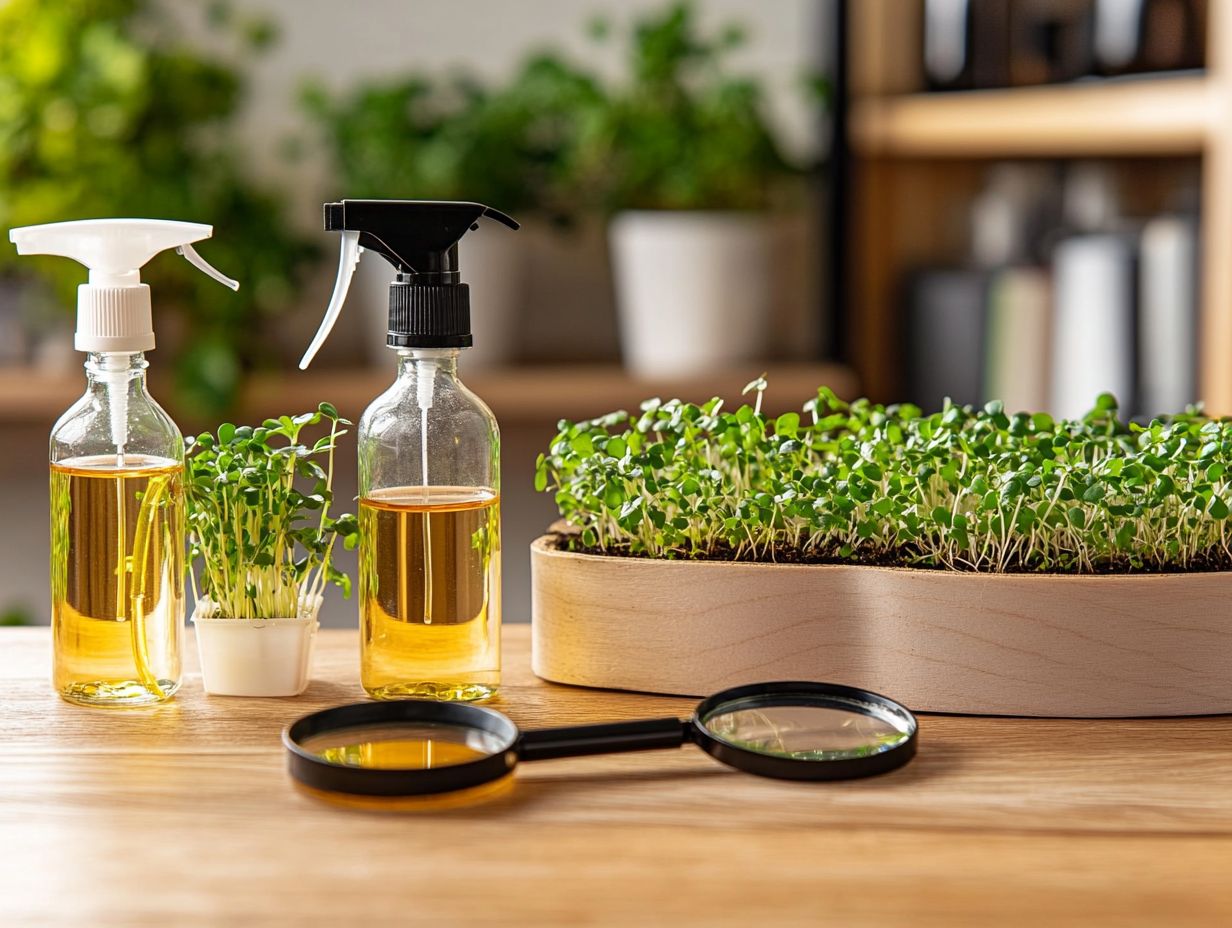
For your business growing microgreens, ensuring safe and effective pest control is essential. It’s not just about maintaining product quality; it s also about adhering to organic gardening standards and safeguarding consumer safety.
Start by establishing best practices in pest management with comprehensive staff training. Your team needs to recognize the signs of pest infestations and understand how to implement preventive measures effectively.
By utilizing smart pest management techniques, you can minimize reliance on chemical interventions. These techniques help you reduce the use of chemicals while embracing a sustainable approach that incorporates natural pest helpers, habitat manipulation, and careful monitoring.
Documenting your practices is crucial. Ensuring that all methods comply with organic standards will keep you on the right track toward organic certification requirements.
By fostering a culture of pest awareness and responsibility within your team, you’ll maintain a healthy growing environment. This, in turn, enhances both product quality and customer trust.
Frequently Asked Questions
Wondering what you need to keep your microgreens pest-free? Here are the top supplies!
The top 5 pest control supplies for microgreens are neem oil, insecticidal soap, diatomaceous earth, beneficial insects, and sticky traps.
What is neem oil and how does it help with pest control for microgreens?
Neem oil is a natural, plant-based oil extracted from the neem tree. It acts as both an insecticide and a fungicide, making it an effective tool for controlling pests on microgreens.
How does insecticidal soap work to control pests on microgreens?
Insecticidal soap is a specially formulated soap designed to kill soft-bodied insects such as aphids, mealybugs, and spider mites. It works by disrupting the cell membranes of the pests, causing them to dehydrate and die.
What is diatomaceous earth and how is it used for pest control on microgreens?
Diatomaceous earth is a powder made from the fossilized remains of diatoms, a type of algae. It works by physically damaging the exoskeletons of insects, causing them to dry out and die.
Can beneficial insects really help with pest control on microgreens?
Yes, beneficial insects such as ladybugs, lacewings, and parasitic wasps can be very effective in controlling pests on microgreens. These insects prey on common pests and help to keep their populations in check.
Are sticky traps a safe and effective method of pest control for microgreens?
Yes, sticky traps are safe and effective for controlling pests on microgreens. They attract pests with a sticky surface, trapping them and preventing them from causing damage to the plants.


